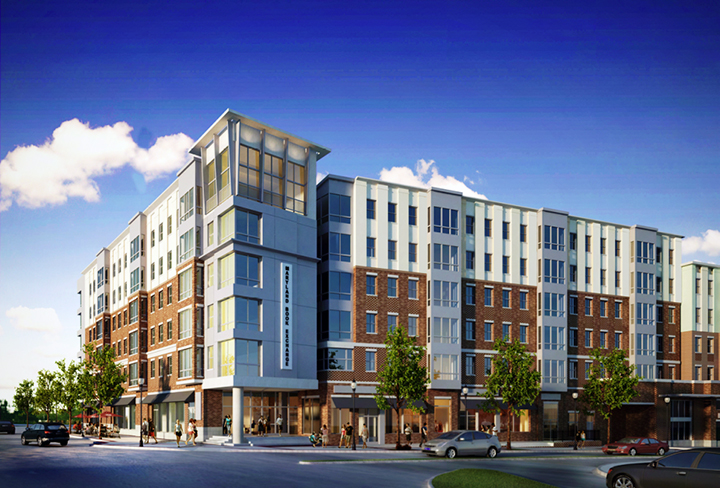
The Maryland Book Exchange complex would provide students with nearby off-campus housing. In the above illustration from January, design plans depict the transformed complex from Route 1.
The building that houses the Maryland Book Exchange has stood at the corner of Route 1 and College Avenue for 77 years. But in the near future, nothing will remain but a pile of rubble.
The former Terrapins gear and textbook store is prepared for demolition in the near future, though city officials have yet to set a specific date. Tearing down the building is the first step of R and J Company’s redevelopment project for the space.
The approved plan includes an apartment complex with 287 units and a maximum of 855 beds, according to the city’s September development update. The plan also includes 13,844 square feet of retail, which will feature the relocation of the Book Exchange.
The time line for construction is sliding a bit, District 3 Councilman Robert Day said, but he said the city will demolish the building by the end of this year. Until workers build the new complex, he said, the Book Exchange will maintain its online presence.
Some residents and city officials, including Day, are concerned about the size of the planned development. The side of the building facing Route 1 will be six stories tall, and the side facing Yale Avenue will be three stories.
“The new developers are going to build a monstrosity,” Day said. “It’s something that is too big for where it’s at. It doesn’t fit the neighborhood, and it doesn’t fit any of the characteristics around it. I think the students may have a different opinion.”
Senior Liz Lane, who lives in the University View, said being in the center of student life on Route 1 makes the Book Exchange area prime real estate.
“While it would be very nice and convenient to live there, I can’t imagine students want to pay much more than the View and The Varsity prices,” she said. “So, unless they find some way to actually give students their money’s worth in housing or jack down the prices to affordability, I seriously can’t see a housing complex doing well there.”
R&J Company could not be reached for contact. However, District 3 Councilwoman Stephanie Stullich said developers have not announced specific prices.
The development could help alleviate the lack of student housing options in the area, Stullich said. But Day said the large number of beds is disconcerting to residents.
“The residents and landlords are starting to work together with the students to create a better atmosphere, and when you dump almost 900 students into Old Town, it creates a lopsided traffic flow with the types of people walking around,” Day said. “There’s always this image that needs to be looked at.”
Stullich said she thinks the development will be in high demand once it’s completed, but she would rather see student housing projects on the west side of Route 1. The Knox Village development planned west of Route 1, she said, is a more favorable project that could foster a community feel.
“[The Knox Village] includes a lot more opportunities for social space,” Stullich said. “There are pretty well thought-out courtyards … and it will include at least one restaurant or bar. Also, I think it’s more attractive architecturally. It will be fairly similar to South Campus Commons in terms of the quality of materials.”
Miriam Bader, a senior city planner, said the Knox Village developers were much more responsive to the city, community and staff than R&J Company was.
Day described R&J Company’s efforts as “disingenuous,” resulting in a pending lawsuit launched by some heated residents.
“One thing [developer Josef Mittlemann] didn’t do, or one thing I don’t think he’s trying to solve, is addressing the community in a way that invited discussion,” he said. “I think he more or less said, ‘This is what we want to do.’ The residents didn’t really like it, so he didn’t really try to continue that conversation and work to solve the problem until we started fighting him at the county level.”



